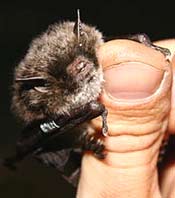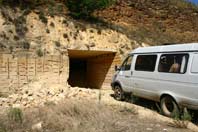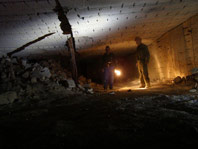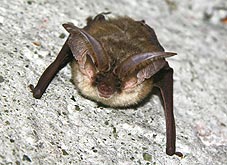
Background
The project is a follow-up to the project executed
by the Ukrainian bat team in 2006–2007 years "Key sites for
cave-dwelling bats of Podillya and Dniester River region".
The current project included all elements of the previous one. Aim,
objectives and methodology of these projects are almost identical.
The difference concerns location of the target territory which is
— now — the continental south of Ukraine, namely Odesa, Mykolayiv
and Kherson provinces.
Since 1999 Ukraine is a party of EUROBATS. According
to the Agreement each party should identify sites which are important
for the conservation of bats; and protect these sites from damage
or disturbance.
The considered territory is extremely rich for artificial
underground cavities: dozens of exhausted quarries systems are known
here, in particular, in Odesa Oblast.  Despite
this fact bats in underground cavities in the region almost had
not been investigated. In 1967 an article by Ju. Volyansky issued
(Волянский, 1967). Unfortunately, exact mentions at location of
inspected by author cavities are absent in the article. And in 2004–2007
a census and observations of bats in few underground quarries of
Odesa province had been carried out (Годлевская и др., 2008). Despite
this fact bats in underground cavities in the region almost had
not been investigated. In 1967 an article by Ju. Volyansky issued
(Волянский, 1967). Unfortunately, exact mentions at location of
inspected by author cavities are absent in the article. And in 2004–2007
a census and observations of bats in few underground quarries of
Odesa province had been carried out (Годлевская и др., 2008).
For today, scales and intensity of mastering of
territories in Ukraine grow significantly. This includes as well
mastering of artificial underground spaces (using quarries for growing
mushrooms, for storing wines, for using them as touristic objects,
for household needs, etc.) or their blocking (for preventing problems
of penetration in cavities of children, etc.). Thus, a big risk
to loose important bat sites is present.
In context of all pointed above, there was a real
necessity of carrying out a full-scale bat census to implement effective
measures for bat conservation, including prevention of full or partial
destruction of their underground roosts in the region.
Main executors
Lena Godlevska (project leader), Maria Ghazali (Schmalhausen
Institute of Zoology of NAS of Ukraine), Volodymyr Tyschenko (National
University of bioresources and nature management of Ukraine).
Main results
 Wide
bat census was carried out in summer 2008 (June–July) and winter
2008/2009 (December, January). Investigations covered three administrative
provinces of Ukraine: Odesa, Mykolayiv and Kherson Oblasts. Totally,
60 points were examined (exhausted and active limestone mines (majority
of objects), military underground objects, cellars). Most of objects
were examined for the purpose of bat census firstly. Wide
bat census was carried out in summer 2008 (June–July) and winter
2008/2009 (December, January). Investigations covered three administrative
provinces of Ukraine: Odesa, Mykolayiv and Kherson Oblasts. Totally,
60 points were examined (exhausted and active limestone mines (majority
of objects), military underground objects, cellars). Most of objects
were examined for the purpose of bat census firstly.
 The
work was carried out by a standard scheme: in summer, visual examination
of shelters and netting of bats during evening departure with a
harp trap and mist nets; in winter, counting hibernating animals
in cavities. All captured bats were examined on a standard procedure
(species, sex, age, weight, measures of a forearm, ear, ectoparasites,
etc.). Checked cavities were described on the common scheme (type,
origin, number of entrances, temperature inside, etc.). The
work was carried out by a standard scheme: in summer, visual examination
of shelters and netting of bats during evening departure with a
harp trap and mist nets; in winter, counting hibernating animals
in cavities. All captured bats were examined on a standard procedure
(species, sex, age, weight, measures of a forearm, ear, ectoparasites,
etc.). Checked cavities were described on the common scheme (type,
origin, number of entrances, temperature inside, etc.).
 In
total, bats were found in 39 sites. 9 bat species were revealed:
Rhinolophus hipposideros, Myotis blythii, M.
daubentonii, M. dasycneme, M. mystacinus
s. l. and M. nattereri, Plecotus auritus
and P. austriacus, Eptesicus serotinus. Most of
the records represent an essential addition on status and distribution
of revealed bat species in Ukraine, generally. For Odesa Oblast
four “new” species were revealed; for Mykolayiv Oblast, two “new”
species. Firstly, a big winter aggregation (>100 ind.) of rare
in Ukraine M. dasycneme was found (for all the period of
zoological investigations a maximal registered number of hibernating
pond bats in one object had not exceeded 10 individuals). In
total, bats were found in 39 sites. 9 bat species were revealed:
Rhinolophus hipposideros, Myotis blythii, M.
daubentonii, M. dasycneme, M. mystacinus
s. l. and M. nattereri, Plecotus auritus
and P. austriacus, Eptesicus serotinus. Most of
the records represent an essential addition on status and distribution
of revealed bat species in Ukraine, generally. For Odesa Oblast
four “new” species were revealed; for Mykolayiv Oblast, two “new”
species. Firstly, a big winter aggregation (>100 ind.) of rare
in Ukraine M. dasycneme was found (for all the period of
zoological investigations a maximal registered number of hibernating
pond bats in one object had not exceeded 10 individuals).
Number of revealed species is comparatively not big.
Generally, small number of species is typical for steppe regions
even if they adjoin closely to “non steppe” areas with high species
diversity. In the study area such “non steppe” plot (corresponding
to another physiogeographic zone — deciduous forest zone) lies at
its north “corner” where 9 from 9 above mentioned species were found.
In the rest of cavities (of typically steppe part) only 5 species
were found. It is characteristic that a total number of accounted
bats is not high — 2324 individuals (with M. daubentonii as a dominants
— 35% from a general number). A total maximum number of bats per
one object amounts 341 individuals.
Basing at census results, few underground cavities
or their compexes, which are highly important for bats, were determined:
one, in Kherson Oblast; one, in Mykolayiv Oblast; and the, rest
in Odesa Oblast.
In 2009 executors started an implementation of some
practical measures on conservation of determined important underground
sites: e.g., including of the determined key sites into the general
national list of key bat habitats of Ukraine, sending Information
letters for local authorities (under jurisdiction of which cavities
are) about importance of underground cavities and inadmissibility
of actions leading to destroying these bat roosts and disturbance
of bats.
Funding
The project was supported by “Direction des Eaux
et Forets” (Luxembourg) and “Ministry of Environment, Nature Conservation
and Nuclear Safety” (Germany) through the EUROBATS Secretariat.
References
Волянский Ю. Е. Зимовка рукокрылых в окрестностях
Одессы // Вестник зоологии. — 1967. — Том 1, № 1. — С. 77–78.
Годлевская Е., Панченко П., Форманюк О. Новые
сведения о троглофильных видах рукокрылых окрестностей г. Одессы
// Раритетна теріофауна та її охорона. — Луганськ, 2008. — С. 93–101.
(Праці Теріологічної школи. Вип. 9.)
|